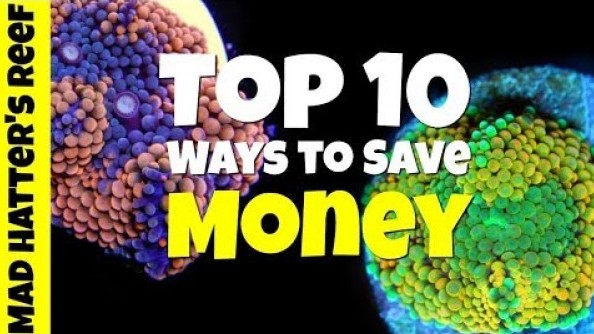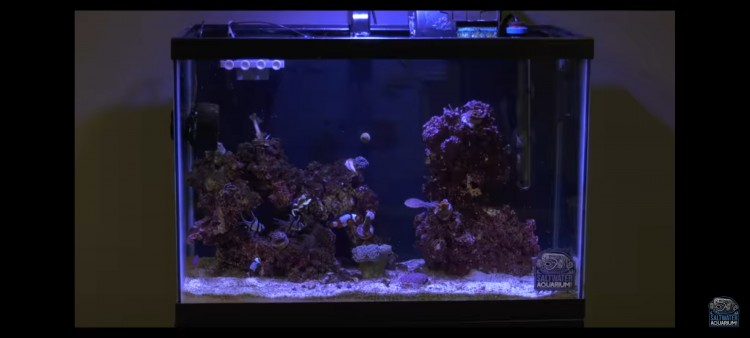Top 10 Ways to Save Money on a Reef Tank by Mad Hatters Reef
- Sep 26, 2019
- Web Aggrigator
- 1277 0 0

This is the top 10 ways to save money when dealing on startiung your reef tank by Mad Hatter's Reef.
10 - Buy the Essentials
Here is a list of the essential equipment needed for a reef tank.
- Heater - Maintaining the proper temperatures in your aquariums is essential, especially if you want good coral growth.
- Protein Skimmer- allows you to remove excess nutrients from your aquarium water
- Lighting - The lights in a reef aquarium is one of the essential pieces of equipment
- Return Pump - Water movement is needed to get your water to and from your filtration system, a return pump is required.
Here is a list of equipment which is not essential for reef keeping. It includes "Controllers, Automatic Testers, Reactors, and Dosing Equipment" none of these are critical to setting up a reef tank. They can reduce the amount of maintenance you perform on your tank. A lot of people get wrapped up in these pieces of equipment and the cost associated with them. They are not necessary to set up and maintain a successful reef tank.
9 - Buy Used Equipment
When buying used equipment, use caution, it's essential to understand the history behind your piece of equipment you are considering buying. Do your research when you are buying used equipment.
Someone asked me if it was okay to buy an aquarium that was once used for a quarantine tank and use it as a display tank? I'm never going to use any equipment that has ever been used as a quarantine system. They could have treated the system with copper. If traces of copper exist and you use it as a display tank, it could cause issues in the future. The potentially cost-saving behind buying new equipment vs. buying used equipment can save you a lot of money. My 220-gallon tank was a used tank I bought which at the time could not afford to purchase that tank new. I found it on Facebook, but there are many different places you can search to find equipment the more popular ones are Facebook Marketplace, Craigslist, and eBay. eBay is probably the best because you can find very a wide range or even very specific equipment. Stay away from the off-brand stuff though. It's usually low quality. Buying used equipment is a great way to save a ton of money. You just need to know what you're buying and who you're buying from.
8 - Start Small
Some people may not consider a 40-gallon tank small tank. It's truly the ideal size to start with when you are first getting into the hobby. Starting with a smaller tank limits the cost associated with it. Everything is less from every single level. A 220-gallon tank has a lot of real estate which means more substrate, more rock, more powerheads, larger return pump, more lights, bigger skimmer, etc.… that does not even consider the amount of fish or coral that you need to make it look like it is not empty. A smaller tank boils down to the fact that it has less space.
7 - Shop at the Dollar Store
Shopping at the Dollar Store is a great way to save money in several different aspects of your life. There are lots of items at the dollar store that are beneficial to you and maintaining your reef tank. From scrubby pads, measuring cups, turkey basters, super glue are just a few items at the Dollar Store that can be used in your reef tank. There are probably a hundred other things you could buy for your tank that are all cheap.
6 - Turn Dry Rock into Live Rock
Live rock is expensive and can break the bank when you're setting up a reef tank. Most people do not realize the cost until they buy some. One of my favorite types of rock is called Real Reef Rock and I it's a human-made rock that is dry most of the time when you purchase it. The problem associated with dry rock is that it doesn't have all the life that live rock has. Live rock is not alive. It has life on it, things like beneficial bacteria, algae, sponges and a bunch of other life, like pods. With real live rock, there is the associated risk of hitchhikers that can cause problems in a reef tank. I like to use dry rock because it's about half a cost. I get the dry rock and put it in a barrel of saltwater with a heater, powerhead, and then add the items I want. You can add things like sponges (which sponges are in incredibly important part to a thriving reef), bacteria, and copepods. I add all these things individually, so I am in complete control of the finished product, and I know what is in my new live rock.
I let the rock sit in a barrel for a couple of months and then once it's done cooking. I then take it and use it in my aquarium. The process will take dry rock and make it into live rock. It takes a bit of planning and a bit of space, plus the added equipment but, it's going to save you a ton of money. The difference between dry rock and live rock is between $4 - $6 depending on where you buy it.
5 - Buy Quality Equipment
Buying quality equipment will cost a bit more, but when you purchase higher quality equipment, you're going to find that it lasts a lot longer. I've made mention of this before. I've bought stuff on eBay and didn't get the best quality product. This is especially true for your essential equipment, purchase good quality products. It doesn't have to be the best, as long as it's good, it's going to serve you in your reef tank a lot better. Some of the cheaper equipment may last maybe a year and then it will need to be replaced. So if you spend a little bit more money upfront, you're going to be a lot better for it.
4 - Quarantine Your Livestock
Most people don't quarantine their livestock and even fewer quarantine their invertebrates. There's a tremendous amount of value in quarantining all of your livestock, including corals. While in the quarantine you can identify if there's something wrong with them before adding them and possibly affecting your display tank with some parasite or pest. Once introduced to your display tank, it can quickly spread or cause significant issues. This is the biggest waste of money, not quarantine fish, invertebrates and corals properly before adding them to my display. A quarantine tank (QT) doesn't take a whole lot to set up. It has a heater, filter and a way to move water, couple places for species to hide and that's it. A QT can help prevent problems before they become huge, costly problems. A QT setup is worth way more than anything else that you can do for your reef tank and livestock.
3 - Buying Corals on eBay
I've done quite a bit of this there is a ton of value in buying corals on eBay. The one thing I stick to is staying with well-known vendors on eBay. You will get that little extra sense of service when it comes to buying corals. I'm sure there's people out there on eBay that are just trying to turn a quick buck and make some fast money. There are some really good vendors on eBay, and there are also some great deals when buying coral and auction on eBay. The best deal I got was a Man of Steel Tabeling Acro that a frag can retail for about $200. I got a purity good size piece for $45, that's more than 50% off! I spent about $200 and got some excellent deals on corals and save a ton of money.
2 - Do Preventative Maintenance
Preventive maintenance is one of the best ways to extend the life of your equipment. You spent a lot of money on your equipment. If you take care of your essential equipment it is going to last longer, it's going to serve you better and will end up operating better. It's going to help you maintain your reef tank, so take the time to clean it. You can use Citric Acid or vinegar and some scrubbing elbow grease. All these things are going to extend the life of your equipment, it may not be the best part of the hobby, but it's an important part and something worth mentioning. That's why it's number two on our top 10 ways you can save money with your reef tank.
1 - Education
There is a ton of content out there on YouTube and websites that focus around educating people and helping them be successful with their reef tanks. YouTube's a great place to get content for free plus there are forms like Reef-2-Reef, which is a great place to get free information. There's a ton of websites as well as my site Matt Hatter's Reef, Reef Builders with great content and product spotlights, there is also Melev's Reef has been one of the pillars of information when it comes to successful reef keeping. The best part about it, it is all for free, it's all takes is a little bit of digging in and finding the information that you're looking for but educating yourself can help you make informed decisions and save you money.






About author
The content found on this page was found and added by Tank Facts to make it easier to learn about new species and keeping all of the found content in one place. The brand and content is owned by the respected individuals and in no way considered Tank Fact